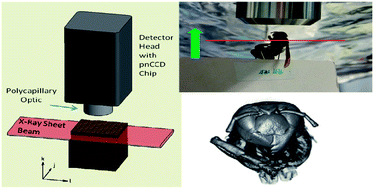Slicing – a new method for non destructive 3D elemental sensitive characterization of materials†
Abstract
Recent advances in synchrotron sources and detector technology have led to substantial improvements in spatial resolution and detection limits for X-ray fluorescence analysis (XRF). However, the non-destructive three-dimensional elemental sensitive characterization of samples remains a challenge. We demonstrate the use of the so-called “Color X-ray Camera” (CXC) for 3D measurements for the first time. The excitation of the sample is realized with a thin sheet-beam. The stepwise movement of the sample allows getting the elemental distribution for each layer with one measurement. These layers can be combined to a full 3D dataset for each element afterwards. Since the information is collected layer by layer, there is no need to apply reconstruction techniques, which quite often are the reason for artifacts in the results achieved by computed tomography (CT). The field of applications is wide, as the 3D elemental distribution of a material contains clues to processes inside the samples from a variety of origins. The technique is of special interest and well suited for biological specimens, because their light matrix minimizes restricting absorption effects. Measurement examples of a hornet and the teeth of a Sorex araneus are shown.


 Please wait while we load your content...
Please wait while we load your content...